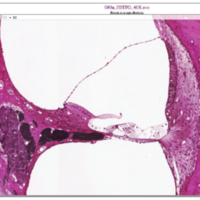Cochlea and Organ of Corti
Dublin Core
Title
Cochlea and Organ of Corti
Subject
Cochlea
Organ of Corti
Description
a given region of the basilar membrane will only move if the incoming sound is at a specific frequency. Because the tectorial membrane only moves where the basilar membrane moves, the hair cells in this region will also only respond to sounds of this specific frequency. Therefore, as the frequency of a sound changes, different hair cells are activated all along the basilar membrane. The cochlea encodes auditory stimuli for frequencies between 20 and 20,000 Hz, which is the range of sound that human ears can detect. The unit of Hertz measures the frequency of sound waves in terms of cycles produced per second. Frequencies as low as 20 Hz are detected by hair cells at the apex, or tip, of the cochlea. Frequencies in the higher ranges of 20 KHz are encoded by hair cells at the base of the cochlea, close to the round and oval windows ([link]). Most auditory stimuli contain a mixture of sounds at a variety of frequencies and intensities (represented by the amplitude of the sound wave). The hair cells along the length of the cochlear duct, which are each sensitive to a particular frequency, allow the cochlea to separate auditory stimuli by frequency, just as a prism separates visible light into its component colors.
Contributor
Cut Rita Zahara
Rights
Craetive Commons
Type
Image
Files
Collection
Citation
“Cochlea and Organ of Corti ,” Open Educational Resource (OER) - USK Library, accessed April 24, 2025, http://202.4.186.74:8004/oer/items/show/1206.


